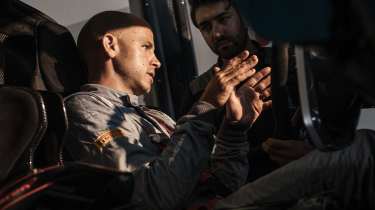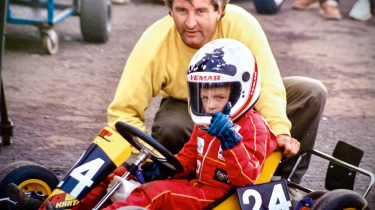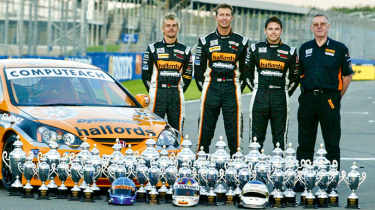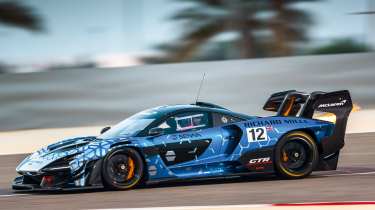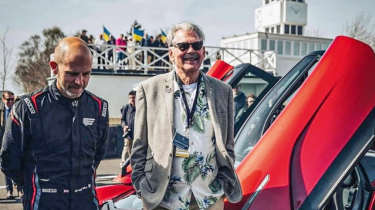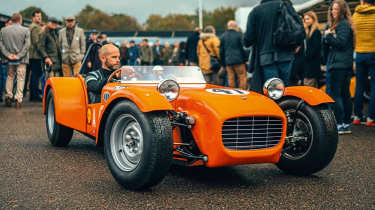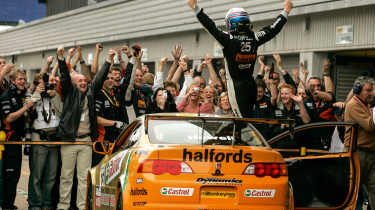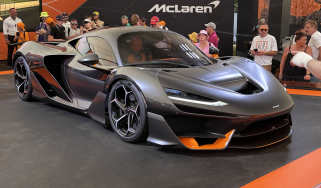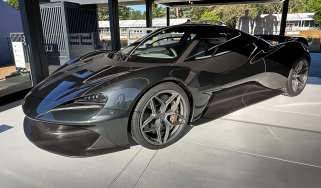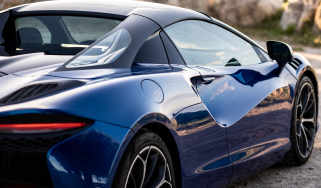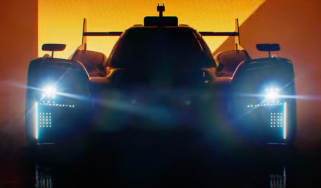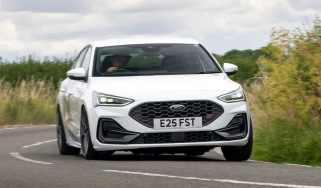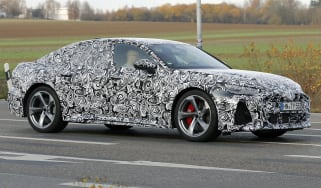From karting in a warehouse to lead McLaren test driver: Gareth Howell’s story
The ex-BTCC racer who’s helped develop every modern McLaren road car, as well as the GMA T.50, on how indoor karting and the power of friendship have shaped his career – and the supercars he tests
Every McLaren road car bears Gareth Howell’s fingerprints. As test driver, he’s had a hand in the development and driving characteristics of each McLaren Automotive model from 2011’s MP4‑12C onwards. He didn’t work on the McLaren F1 – he was at primary school while that car was being designed – but during a three-year sojourn from McLaren he did develop its spiritual successor, the T.50, as chief test driver at Gordon Murray Automotive.
Prior to being an automotive industry test driver specialising in supercars, Howell was a professional racing driver and a touring car specialist in particular, with a nine-year spell in the British Touring Car Championship including a hat-trick of race wins.
> Used McLaren 650S (2014 - 2017) review – a 207mph supercar for Audi RS3 money
‘My dad got me started in it all,’ Howell says. ‘I don’t come from a wealthy background; I grew up in a three-bed semi in South London, but my dad pioneered the concept of indoor karting. In 1986 he was running some karts on an outdoor circuit on some wasteland near where Canary Wharf is today. It was pissing with rain and he and his business partner looked up at the big unused old banana warehouse next to them in the Docklands… and they had an idea.
‘I remember being five or six years old and getting a day off school to help Dad “acquire” some excess traffic cones, throwing them onto the back of a flatbed truck, to mark out the track in the warehouse. It became the new craze that bankers in London did for fun, and went from strength to strength. Dad’s company, Playscape, was a bit of a trailblazer at bringing motorsport to the masses and enabling anyone to try it – who hasn’t done indoor karting these days? I’m very proud of him for that.’
Growing up with access to a kart track meant Howell was able to hone his driving skills from a tender age; he just needed an opportunity to get out and race for real. ‘When Dad was buying job-lot fleets of karts from Martin Hines at Zipkart, he asked: “Why don’t you throw in a Cadet kart as well?”’ At eight years old – the youngest age drivers can compete nationally in the UK – Howell started competing in Cadet championships (the fiercely fought karting formula for eight to 12-year-olds). The after-hours practice at the indoor track paid off: he was competitive straight away. ‘My first race was with [future F1 and WEC driver] Anthony Davidson, and we followed each other through the karting ranks, becoming teammates for Martin Hines’ Zip Young Guns team in the early ’90s.’
Howell’s contemporaries included plenty of other future stars. ‘I found a photo the other day of a big group of us at an end-of-season event at Dad’s track. It’s a bit of a who’s who of our generation: drivers like Jenson Button, Dan Wheldon, Gary Paffett, Mike Conway, and a little lad on the end in a blue suit: Lewis Hamilton.
‘Today karting is incredibly expensive, which is a real shame. We’d always managed to get by, with a free kart and pulling a bit of money from the business to pay for tyres. But we were kind of at the turning point where there were a few big Winnebagos starting to turn up in the paddock, and fewer dads and lads running a kart out of the back of their Sierra.’
That meant it was time to make the jump into cars, aged just 16. ‘I started racing Fiestas. I remember the lights going green for my first race and suddenly realising I’d never done a racing start. I had to learn quite quickly…’ When Ford created the Fiesta Zetec Challenge to support the BTCC, Howell and Gordon Shedden scrapped for the title in 2000. As winner of the Junior Cup award for young drivers, Howell was given a test in the Prodrive-run works Ford Mondeo – a front-running car at the end of the high-tech, big-budget Super Touring era. ‘That was special. That was my first realisation that, “Wow, touring cars are serious kit.”’ Howell made his BTCC debut in a privateer Ford Focus in the production-based Class B the same year. ‘I’d always been a massive BTCC fan; I had all the Duke Video tapes as a kid. I loved the tight racing, the crash, bang, wallop of it, the Murray Walker commentary.’
His top-class break was in 2002 with West Surrey Racing (the team which won the 2024 BTCC driver’s title), then running a pair of MG ZSs sponsored by pop group Atomic Kitten. ‘Which didn’t do my street cred much good, especially when they gave me a road car with “Atomic Kitten” down the side of it. I’ll never forget my teammate Colin Turkington and I had to dance at the launch of the car, as the smoke cleared and the car span round. The car looked great – our dancing didn’t!’
Although he finished ahead of Turkington in the points table, Howell didn’t have the funds to continue with the team at season’s end. Team Dynamics’ boss Steve Neal, who passed away last year, gave him his next chance. ‘There are certain points in anybody’s career which are a catalyst to other things in life, and Steve’s faith in me was an enormous help. He would always try and get me out there in the car if he could. For 2004 I was down to race alongside Matt Neal in the Honda Civic Type R. We did the press day with my name on the car – and then Dan Eaves came in at the 11th hour with Halfords sponsorship and got the drive instead. But I pitched up at every round. Steve let me have a hotel room with the team, help the boys with tyres, make the tea – and I did. It was pretty soul-destroying; I was holding Dan Eaves’ pitboard during races. But that meant a lot to the team. And when midway through 2005 they got backing from Castrol for an extra car, that was my call-up.’
He competed in the final three rounds of the year, winning the last race at Silverstone. He won another two races in 2006 but, again, limited budget curtailed the opportunity for a full season. ‘After a couple of years with lower teams and privateers I was pushing 30, I’d met my now wife Laura and was worrying more about impending mortgages, and starting a family. As life got more serious, I needed a more stable career than racing – and I thought of the automotive world.’ Just as Steve Neal was a catalyst and mentor for Howell’s racing career, so would racing-driver-turned-automotive-test-driver Chris Goodwin be for his second career in road car development. Goodwin was working for the nascent McLaren Automotive, at that stage finishing off the Mercedes SLR project.
‘I knew Chris enough to say hello, so I got his number and called him up. He explained they were just finishing the SLR but, with McLaren’s own road cars on the horizon, he would be in need of somebody to help with the increased workload. It was left as a “keep in touch”. So I did: I rang him once a month – for about a year.’
It paid dividends. ‘I built a relationship with Chris as I went; I wanted him to want to give me the chance. It started with the MP4‑12C and I’ve worked on every McLaren car since, plus track cars like the P1 and Senna GTR, 620R and the 570 GT4 racing car.
‘I came into the test drive world with a racing driver’s mentality, but quickly found out it’s a very different discipline. One of the first days I did was at Dunsfold in an original MP4‑12C development car. I did a couple of laps, and the engineer in the passenger seat asked me a very studious question about a very specific thing we were assessing, and I thought, “Ah OK. It’s not all just about oversteer and understeer anymore, is it?”
‘The biggest thing to learn was that I’m not setting the car up for me alone; it’s for a whole breadth of different drivers. You can’t set it up to be on edge, or drive around problems yourself as you can in racing. You also need to listen to opinions of others much more. I’ve got a great fellow test driver here at McLaren who’s also been here since Day One, Dani Marcos. We bounce ideas off each other to achieve the end goal – great cars. We’re all real perfectionists and never happy, and that’s a good thing.’
Howell worked with one of the car world’s most famous perfectionists during his sabbatical with Gordon Murray. ‘It was an unbelievable programme to be involved with, and I was amazed to get the role there,’ he recalls. ‘I sent an email on a whim, to Gordon. A one-liner saying, “I’m really interested in what you’re doing, would love to have a chat.”
‘Two weeks went by, and I thought he’s going to use an ex-F1 driver or someone instead. Then his PA got in touch to arrange a meeting. It was during Covid, so it was over Zoom. All of a sudden that famous beard and hair popped up on my screen – it was quite surreal to be talking about a role with somebody who had worked with most of my racing heroes!
‘Early in the project Gordon said, “Well, of course, you must drive the F1. I’ll sort that out,” and soon enough I was driving the maroon McLaren F1 formerly owned by Rowan Atkinson, albeit down a wet, cold A-road, very carefully. It was still an awesome experience.
‘T.50 was special to work on, and I was over the moon to see how well it has been received. But I wanted another challenge – and to grow more with McLaren I suppose.’ Howell returned to McLaren Automotive at the end of 2023. As we interview him, he’s taking a break from test weeks away in the W1, McLaren’s upcoming 1257bhp hybrid hypercar.
What about his own road cars? ‘I was a front-drive hot hatch fan growing up, mostly thanks to Dad’s choices for the family car. They were never sensible; we had some great ones, including a 205 GTI, Renault 5 Turbo and Fiesta XR2.
‘My first couple of cars were Fiestas, generally ones I begged from dealerships in exchange for some stickers and a few tickets to watch me racing. The Zetec S I had was particularly fun for a 19-year-old on the road, and could handbrake turn on a sixpence! While working with Gordon Murray I was driving an Alpine A110 GT for a year or so. Gordon had an A110 as his daily and kept singing the praises of it as a package. A guy from Alpine Poland got in touch and loaned us one. That was a lovely, balanced car: it’s lightweight and has suspension that just “pops” really nicely from road inputs.
‘That’s something I like in cars,’ he adds. ‘I want to feel the road and feel a bump without it clattering the platform excessively. In a big, soft car, for example, you’ll hit a bump and it can take an age to settle itself. The car is always therefore “recovering” as it hits the next road input. For me, it’s important that a supercar deals with bumps quickly and the driver isn’t losing connection to their inputs during a prolonged recovery phase. Your secondary ride comfort across more broken road surfaces should be pretty clean, a little like a magic carpet, whilst still feeding road texture through to your hands at the wheel.
‘My daily is currently a Fiat 500, though! Lots of professional drivers I know drive nondescript “A to B” cars on the road. I spend my life going up those carousels in airport car parks, rushing to or from a week away testing, then it’s quick – well, quick-ish – and easy back through the country lanes from the M25 to get home. And it’s manual. The T.50 rekindled my love for a manual shift after years preferring the ease of auto. Even if you’re in a 1.2-litre Fiat you can still have fun with some heel and toe and a damp roundabout! Two of the things working with Gordon really instilled in me: manual gearboxes and light weight. The latter is getting harder and harder to maintain with electrification, but it’s of primary importance to a great handling car.
‘One of the best things I’ve learned is to go with your gut. Your first few miles in a car are generally the most accurate your “feel” will be, it’s reactive. What’s jumping out at you as a test driver, good and bad, will likely be what a customer experiences too. Trusting your instinct is a great lesson I’ve learned as a test driver – and in life too.’
This story was first featured in evo issue 329.
